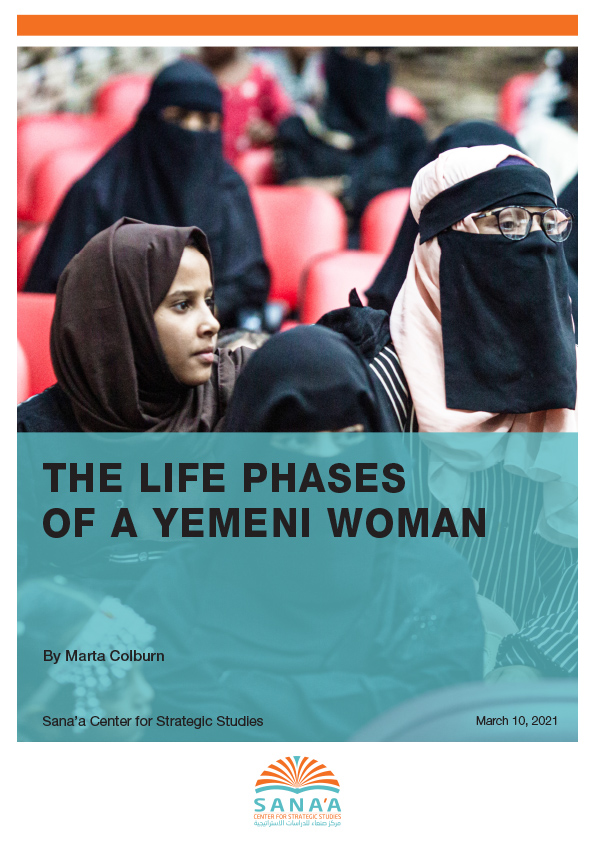This study examines the diversity of experiences of women and girls in Yemen who face differing gender dynamics and challenges at various stages in their lives. It explores age-specific issues during five phases of life for girls and women in the following categories:
- Birth, Infancy and Childhood (0-9 years of age);
- Puberty and Adolescence (10-17 years of age);
- Youth (18-29 years of age);
- Middle Age (30-49 years of age);
- The Twilight Years (50+ years of age).
This study looks at underlying gender dynamics and cultural, social, political and economic challenges at each phase, as well as noting salient changes in the context of the war and the massive humanitarian crisis in Yemen. Proverbs are presented in each section to illustrate commonly encountered attitudes and beliefs about women at various stages in their life, which reflect complexities in Yemeni society and encompass contradictory ideas and norms. Each section also includes profiles which are composites of real women and girls whom the author has encountered over decades of living, working and conducting research in Yemen. The study seeks to present information that can contribute to gender-sensitive programming in Yemen. The final section includes recommendations for each age category addressing key issues examined in the study.
Findings and Recommendations
The following table presents findings from this study and recommendations organized by age group. These offer guidance for donors and those implementing programs to better address the needs of girls and women.
|
Findings |
Recommendations |
|
|
BIRTH, INFANCY AND CHILDHOOD (0-9 years of age) |
||
|
1. |
With the conflict, school enrollment rates have deteriorated for all children, including girls. Education is critical to addressing a wide range of gender issues. In the current crisis the government and local authorities face challenges to maintain the functioning of the education system. |
It is suggested that efforts to improve girls’ enrollment seek community and family support to provide incentives for female teachers, engage mothers and fathers in awareness raising efforts about girls’ education and emphasize that education for girls can contribute to better employment and income earning opportunities. |
|
2. |
Corporal punishment of children is a challenge both in the home and in school. This phenomenon negatively impacts the emotional and educational development of children. |
In more stable areas of the country, consider piloting an awareness raising campaign combatting corporal punishment, potentially as part of a broader social cohesion initiative addressing conflict dynamics and the increase in violence in schools. |
|
PUBERTY AND ADOLESCENCE (10-17 years of age) |
||
|
3. |
Cultural gender beliefs in Yemen (i.e. women being categorized as du’afa, the potential for fitna and conceptions of family honor) shape ‘protective’ practices designed to shelter girls and women. |
Organize tandem workshops for young women and their maharim to: magnify the impact of training; foster changes in family gender dynamics; and support women’s careers, as well as contribute to employment readiness for young men. |
|
4. |
Child marriage has been a challenging issue in Yemen for decades, but since 2015 it is believed to have increased significantly as a negative coping strategy for destitute families to mitigate economic vulnerability and insecurity. |
Seek to implement interventions to improve income-earning capacities and skills with girls at risk and survivors of child marriage and other forms of gender-based violence, mixed with other categories of vulnerable women (to mitigate against stigmatizing individuals), folded into broader economic empowerment activities. |
|
YOUTH (18-29 years of age) |
||
|
5. |
Entrepreneurship and resilience are hallmarks of Yemeni culture and have mitigated the devastating impact of the current crisis, with women playing an active role, particularly in urban areas, though humanitarian and development efforts seeking to improve income earning often reinforce gender roles. |
It is suggested to conduct low profile research among female entrepreneurs to provide strategic insights. Microfinance and income-generating activities for women should seek to build self-confidence, negotiating skills and creative problem solving. Explore ways for such activities with vulnerable women to engage men in the family. |
|
6. |
A positive development observed has been that with increasing economic activity among women there is now growing social acceptance of such activities, which may signify more enduring changes to gender norms. It is unclear if such changes are temporary in nature. |
Consider launching a broad public campaign that highlights the positive contributions of women during the conflict, seeks to impact the public discourse on gender and celebrates the positive roles of both men and women during the crisis. The campaign could engage public opinion influencers such as imams, tribal leaders and media figures. |
|
MIDDLE AGE (30-49 years of age) |
||
|
7. |
The lack of affordable female-friendly transportation options in rural and urban settings exacerbates gender disparities in accessing services and existing gender biases. |
Options to explore in urban areas could include: mobile phone taxi apps in cities (similar to Kareem or Uber); transportation vouchers for vulnerable women; and women-driven taxis. Outside of cities options could include motorcycles operated by women, and hybrid taxis. |
|
8. |
Yemeni women’s experiences and gender dynamics are diverse; humanitarian response efforts too often prioritize quick impact activities, thus potentially harming the elderly, disabled and socially marginalized groups, including girls and women. |
It is suggested that gender analysis is integrated into all project phases, with meaningful input from qualified local gender specialists. Support local academic and civil society activities to build additional capacity in the area of gender analysis to improve gender-sensitive programming. |
|
THE TWILIGHT YEARS (50+ years of age) |
||
|
9. |
Despite the depth of the crisis in the country, Yemenis demonstrate high levels of resilience, both at the individual and communal level. Support networks contribute to resilience and women play a significant role in building and maintaining social solidarity through various practices. |
Consider supporting research on sources of resilience in the Yemen context, examining how social solidarity works in specific areas and exploring the role of women in resilience. Additionally, small scale research initiatives can explore resilience factors among women to help inform interventions that will sustain and not damage such elements. |
|
10. |
The elderly, with a preponderance of older women, and the disabled, often face challenges in collecting food rations and other aid. Such challenges lead to a reduction in assistance, as vulnerable beneficiaries often have to give a portion of their ration to others for collection and transportation. |
Ensure that distribution sites accommodate the needs of the physically vulnerable such as elderly women. Engage third party monitoring entities to assess if such practices are in place. If such distribution arrangements prove too complex, those with mobility issues could be provided additional rations or cash to cover transportation costs. |

 اقرأ المحتوى باللغة العربية
اقرأ المحتوى باللغة العربية
